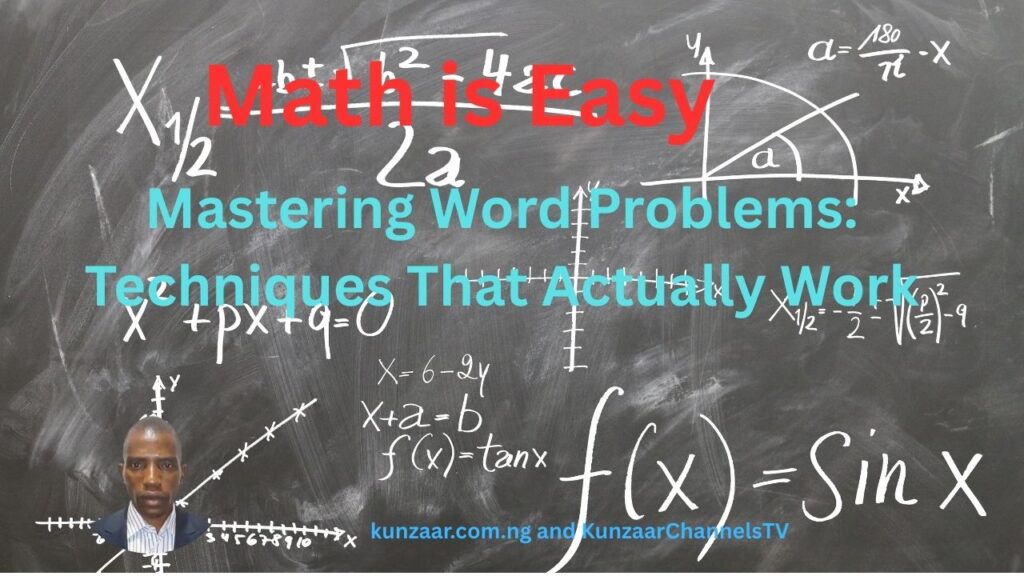Introduction
Word problems can be a source of frustration for many students. Many students have been finding it very difficult to understand the method used in solving word problems. Unlike straightforward equations, word problems require critical thinking, comprehension, and mathematical skills — all at once.
What is Word Problems?
Wors problems in mathematical exercises presented as scenarios or stories that require the application of mathematical operations to find a solution. They differ from traditional equations by embedding numerical information and questions within a narrative, making it necessary to decode the text and apply mathematical concepts in a real-world context.
But the good news is: with the right approach, you can master word problems.
This guide will show you techniques that actually work, using step-by-step methods and real examples to make things easier.
Also Read: How to Convert Fractions to Decimals (and Vice Versa) Easily
Step 1:
Read the Problem Carefully
The biggest mistake most students make is to rushing through the question and begin to attempt the question without going through it.
Take your time. Read the problem at least twice to understand:
What is being asked?
What information is given?
Are there any keywords that hint at operations?
Tip: Underline or highlight key details and numbers in the question.
Step 2:
Identify and Organize the Information
Once you’ve read the question, extract the data and lay it out clearly.
Then Ask These Questions:
What do I know?
What do I need to find?
What formula or operation might help?
Tip: Draw diagrams or write down variables (e.g., let x = the number of apples).
Step 3:
Choose the Right Operation(s)
Here’s a quick guide to keywords and their operations:
Keyword Operation
Total, altogether Addition (+)
Difference, how many more Subtraction (−)
Each, per, times Multiplication (×)
Share, divide Division (÷)
Tip: Translate the words into a math sentence or equation.
Step 4:
Write the Equation
Use your organized info to form a mathematical expression or equation.
Example 1:
Word Problem: Sarah bought 3 notebooks for $5 each and a pen for $2. How much did she spend in total?
Step 1: Understand what’s happening — she bought 3 notebooks and 1 pen.
Step 2: Notebooks = 3 × $5 = $15
Step 3: Add the pen → $15 + $2 = $17
Answer: Sarah spent $17
Example 2
With Variables:
Problem: John is 5 years older than his brother. Together, their ages add up to 29. How old is John?
Let the brother’s age = x
Then John’s age = x + 5
Total = x + (x + 5) = 29
2x + 5 = 29
2x = 24 → x = 12
John = x + 5 = 17
Answer:
John is 17 years old
Step 5:
Solve and Check Your Answer
After solving, go back and re-read the problem. Plug your answer back into the scenario.
Does it make sense?
Does it fit the conditions in the question?
Bonus Techniques for Difficult Problems
1. Break Big Problems into Small Parts
Don’t try to solve everything at once. Tackle it step by step.
2. Draw a Picture or Diagram
A simple sketch can make the problem clearer — especially for distance, area, or geometry questions.
3. Use Logical Reasoning
Even before writing equations, try to reason out possible answers. Eliminate impossible options.
4. Practice Pattern Recognition
Many word problems repeat structures. The more you practice, the faster you’ll spot patterns.
Practice Problem Time!
You Can Also Read: History of Fulani People
Try this one now:
A farmer has 24 apples. He gives 5 to each of his 4 neighbors. How many apples does he have left?
5 × 4 = 20 given away
24 − 20 = 4 apples left
Summary
Steps to Master Word Problems
- Read carefully
- Identify important info
- Choose the correct operation
- Write the equation
- Solve and check your answer
Final Word Problems Thoughts
Word problems might seem scary at first, but they train your brain to think critically — a skill that goes beyond math.
With these techniques, you can tackle word problems with confidence and accuracy.

